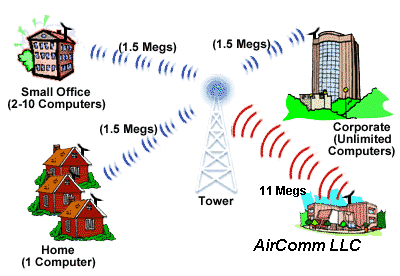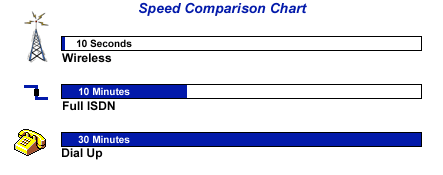Wireless Internet access is exactly
what it sounds like. Getting your connection to the Internet, without the use of
phone or cable lines. AirComm LLC wireless service uses new technology to
provide connection speeds up to 2 Megabits per second. That's faster then a
standard T-1 line, up to 60 times faster then your 28.8 Kbps modem!
How does it
work?
Using a new technology, we are able to send information to various antennas
throughout our coverage area. That information is then re-broadcast and received
by the antenna we provide to you. It's that simple!


Where is it available?
Our wireless coverage will cover the immediate Holiday area and surrounding
communities. We plan on branching out to New Port Richey, Tarpon Springs,
Palm Harbor, Port Richey, Hudson and Bayonet Point shortly.

Comparing
Fixed Wireless Solutions To The Alternatives
In the New World, all of the data transport alternatives will play a role in
providing high-speed data to customers. Each
method will have benefits that make it suitable for a given application and
trade-offs that make it unsuitable for others.
Table 1 lists some of the transport alternatives.
In
addition to the data rate limitations, we must look at other issues revolving
around the transport stream decision. Although
twisted pair copper is readily available to 99 percent of all users, the data
rate is unacceptably slow for broadband data and provides no path for video are
combinations of data, voice, and video. Twisted
pair copper does provide lifeline services, in that the power to run the system
is supplied over the network connection.
Enhanced
copper concepts such as xDSL have the potential to be made available to a great
number of users since they use a twisted pair line.
However, rollout of services limited since the technology limits the
physical distance from a pop. For
acceptable high bandwidth use, xDSL have distance limitations of 18,000 feet
from the pop. Additionally, since
this is not a dedicated bandwidth solution, actual upstream and downstream rates
will vary with a number of subscribers on the system at any given time.
Fiber
appears to be the best solution for symmetrical high-speed data.
Gigabit speeds are readily available in fiber-optic cable.
Additionally it is being installed most large businesses today.
Fiber capable of OC-3 rates can be installed relatively cheaply inside
new or existing facilities. However,
the installation of fiber outside the facility can be expensive and require
substantial time to complete due to the amount of underground work required.
Hybrid
fiber coax (HSC) provides
asymmetrical data via a combination of fiber in the backbone network structure
and a hybrid coaxial/fiber cable to the end-user.
Cable is currently seeing an increase in usage in the business market but
at present is primarily a residential access technology and runs to relatively
few businesses.
Satellite
technologies such as broadband satellite and very small aperture terminal (VSAT)
provide asymmetrical data flow to the user.
Although a single satellite can cover a wide footprint for point to
multipoint solutions, the usage is not expanded according to expectations,
possibly because, in the case of broadband satellite, the downstream path is
from the satellite while the upstream path is via conventional twisted pair
phone line requiring multiple modems.
Although
each of the methods listed above has its advantages, broadband fixed wireless
solutions bridge several of the disadvantages of the others and bring unique
advantages providing symmetrical, fiber quality, I data rate information variety
of situations, broadband fixed wireless solutions are quick to install, with no
external construction required. Leading-edge
technology enables the use of unobtrusive rooftop antennas, eliminating the need
for trenching in cable and fiber solutions and costly towers in previous
wireless products. This makes
broadband fixed wireless solutions perforate alternatives when high-speed,
high-quality and quick time to market are critical success.
Convergence
is real.
 As
we continue to see the need for connectivity increase in the convergence of
voice, video and data becomes real service providers will be required to look
for alternatives to doing business in the old-fashioned way.
The new Internet economy demands that high-quality service be available
to all that wanted. In the near
future, you'll no longer be acceptable to ignore facility (or a single customer
within a facility) because the facility has no access.
Customers are demanding service. The
amount of time when a customer calls to when they expect service will be counted
in hours -- not weeks or months. This
requires that service providers have had their disposal a variety of
alternatives to solve a customer's need for connectivity quickly and
efficiently. These alternatives
must provide cost-effective, scalable solutions that not only result in
acceptable solutions to the end-user but also enable profitable revenue streams
for the service provider.
As
we continue to see the need for connectivity increase in the convergence of
voice, video and data becomes real service providers will be required to look
for alternatives to doing business in the old-fashioned way.
The new Internet economy demands that high-quality service be available
to all that wanted. In the near
future, you'll no longer be acceptable to ignore facility (or a single customer
within a facility) because the facility has no access.
Customers are demanding service. The
amount of time when a customer calls to when they expect service will be counted
in hours -- not weeks or months. This
requires that service providers have had their disposal a variety of
alternatives to solve a customer's need for connectivity quickly and
efficiently. These alternatives
must provide cost-effective, scalable solutions that not only result in
acceptable solutions to the end-user but also enable profitable revenue streams
for the service provider.
Packet
based broadband fixed wireless networks provide the service provider with that
answer. Broadband fixed wireless
networks provide the flexibility to quickly install new links in any part of the
network where connection is needed. Wireless
access provides the service provider with a cost-effective solution that
minimizes the upfront investment, enables a service provider to activate new
links with little or no recurring costs, and provides the service providers with
a product differentiation that set them apart from the competition.
-
Dale Smith, Cisco Systems.